Winter mushrooms offer an intriguing subject, especially regarding their culinary and ecological roles. Varieties like Winter Chanterelles and Velvet Shank enhance seasonal dishes while providing essential nutrients in colder months. Exploring the unique traits and advantages of these fungi can enrich one’s understanding of foraging and sustainable practices. However, what specific conditions enable these mushrooms to flourish in winter, and how can one safely identify them in the wild?
Edible Winter Mushrooms
Winter offers an exciting chance for foragers to discover a range of edible mushrooms that flourish in colder weather. Notable species include winter chanterelle, snowy waxcap, meadow waxcap, velvet shank, and wood ear, each providing unique flavors and textures. Recognizing these mushrooms enhances culinary experiences and adds to the joy of winter foraging.
Winter Chanterelle
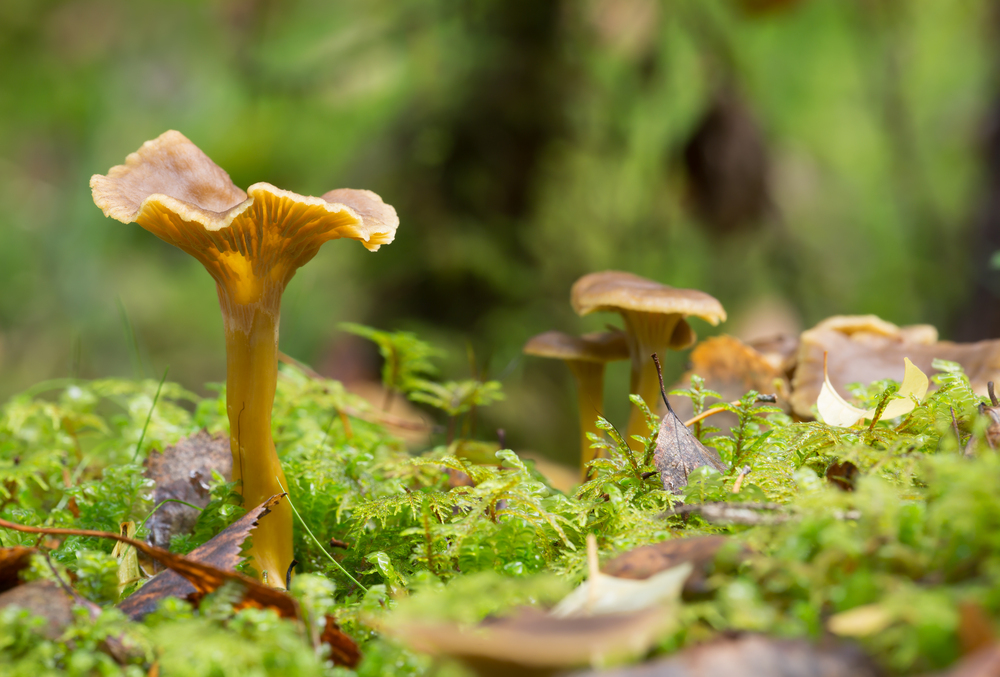
Often overlooked during winter foraging, the winter chanterelle (Cantharellus tubaeformis) is a delightful and versatile edible mushroom. Commonly known as the funnel chanterelle or yellowfoot, it typically appears from late September to December, thriving in coniferous plantations, especially those with spruce, and on mossy slopes within deciduous forests.
This mushroom features a trumpet-shaped cap that ranges in color from ochre to yellowish hues, measuring about 2-4 cm. With its wrinkled cap, wide-spaced gills, and slightly flattened, hollow stem, it is relatively easy to identify, even for novice foragers. The entire mushroom emits a pleasant, spicy, and fruity aroma.
Despite its thin flesh, the winter chanterelle is abundant, often found in large quantities, particularly in wet years. This makes it a prized find for those who embrace the adventure of winter foraging. Its delicate flavor and versatility in culinary applications, along with its suitability for drying, enhance its appeal, inviting foragers to explore the joys of winter mushroom hunting.
Snowy Waxcap
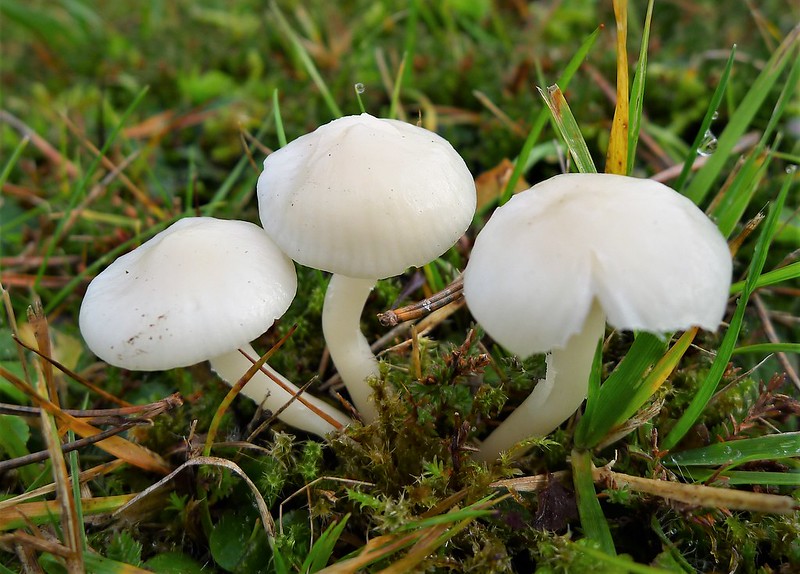
The snowy waxcap (Hygrocybe virginea) is a striking winter mushroom that can transform a frosty terrain into a scene reminiscent of light snow. It features a cap that measures 2 to 6 cm, starting off domed before flattening into a convex or funnel-like shape. The gills are widely spaced, decurrent, and have a distinct waxy appearance. The cylindrical stem is white, often slightly curved and darker near the base, and lacks a ring.
Typically appearing in late autumn and early winter, this mushroom is found singly or in small clusters across unimproved grasslands, mature pastures, parklands, churchyards, and lawns, preferring acid soils. Its spore print is white, and its aroma is rather indistinct.
Foragers should note that while the snowy waxcap is the most common of the wax caps, it should be harvested in abundance only where it is plentiful, as its habitat is increasingly threatened. Leaving some behind helps sustain local invertebrate populations that rely on this mushroom for winter nourishment. Embracing the snowy waxcap can enhance both our culinary experiences and the ecosystem.
Meadow Waxcap

Among the edible mushrooms available during the colder months, the meadow waxcap is notable for its distinct characteristics and culinary potential. Also known as the meadow waxy cap, salmon waxy cap, or butter meadowcap in North America, this mushroom thrives in temperate grasslands and woodlands across Europe.
The meadow waxcap is easily identifiable by its large, waxy cap, which ranges from 2 to 7 cm in diameter and displays a yellowish to peachy-buff hue. Its gills start white and gradually match the cap’s color, offering a thick, decurrent appearance. The chunky, cylindrical stem, typically similar in color to the cap, lacks a ring, aiding identification.
Although the meadow waxcap is often overlooked, it possesses a rich flavor, making it a worthy addition to winter foraging pursuits. Its fruiting period extends into early winter, thriving in unimproved grasslands and meadows. When foraging, be mindful of its habitat; sustainable collection helps ensure this abundant species remains plentiful for future seasons.
Velvet Shank
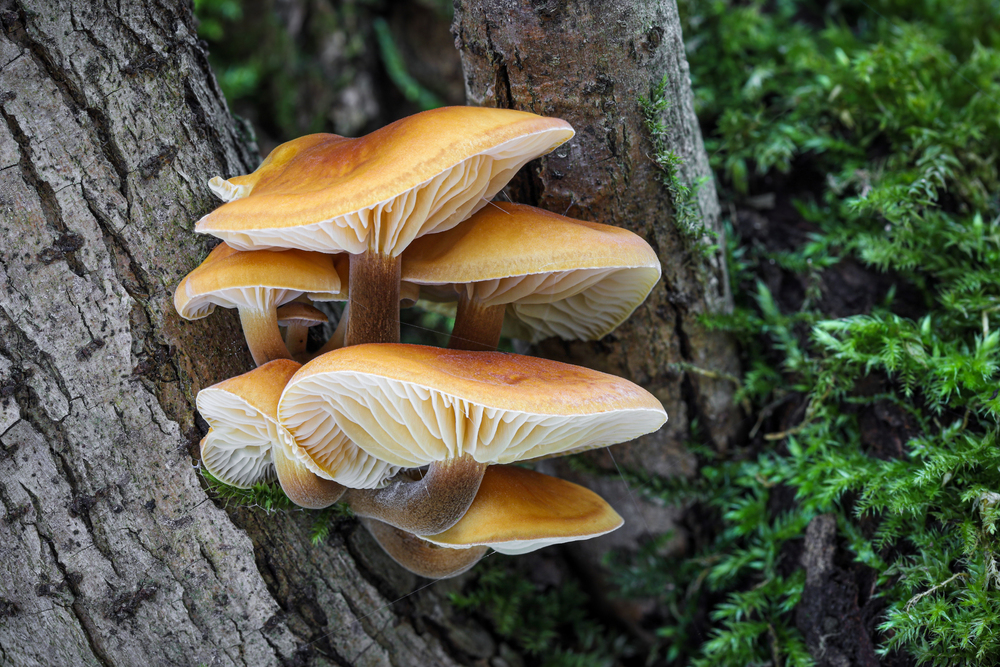
The velvet shank (Flammulina velutipes, aka wild enoki) is a distinctive edible mushroom that thrives during the winter months. Typically found in clusters on deciduous trees, it can be foraged from September through April, flourishing in temperatures above freezing and withstanding brief frosts.
This mushroom is recognizable by its slightly greasy, orange, flat cap, pale yellowish gills, and shiny, dark, velvety stem. The cap measures between 1 to 6 cm, while the stem ranges from 2 to 8 cm in length and 0.3 to 0.8 cm in thickness. Although it has a mild flavor, its winter availability appeals to foragers looking to enjoy the outdoors.
In culinary applications, the tougher parts of the stem are usually removed before cooking, allowing for various preparations. Interestingly, the cultivated enoki-take, favored in Asian cuisine, is genetically identical to the wild velvet shank, differing mainly in cultivation conditions that produce a white mushroom with a long stem.
Wood Ear
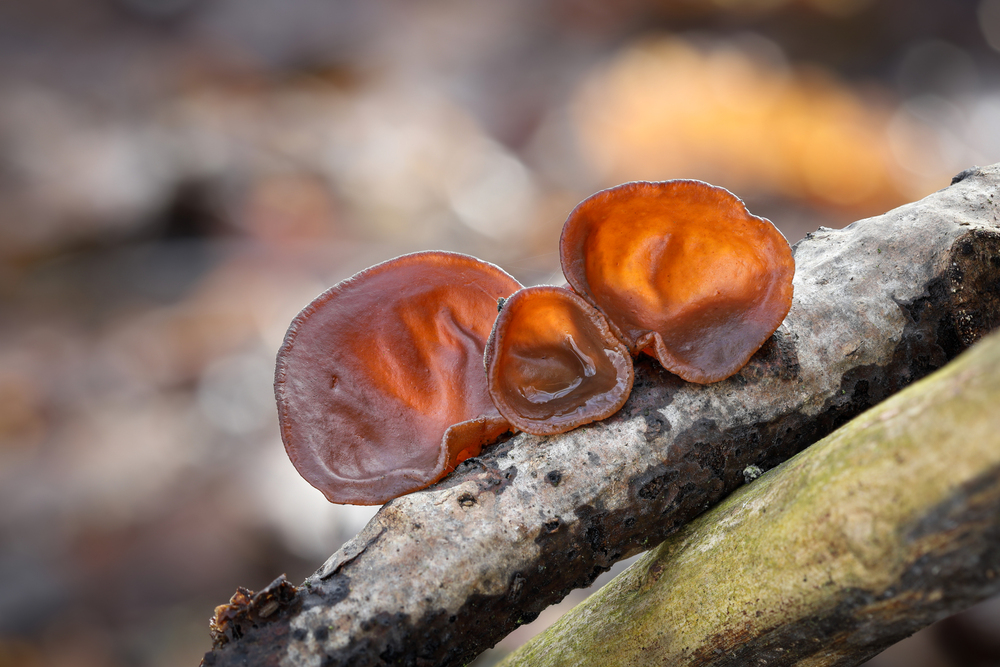
Foraging for wood ear mushrooms (Auricularia auricula-judae) provides a unique experience in winter when these edible fungi thrive in cooler temperatures. Characterized by their ear-shaped, jelly-like appearance, wood ears typically range from 2 to 8 cm across, displaying a dark tan hue with subtle purple undertones. They often grow in clusters on the damaged wood of living elder trees, making these habitats ideal for foragers.
This versatile mushroom is a staple in Asian cuisine, often featured in stir-fries and noodle dishes. Marinating them in tamari or miso sauce enhances their flavor. When frying, it’s important to shred them finely to avoid gas build-up, which can lead to explosive mishaps in the kitchen.
Wood ear mushrooms are rich in antioxidant fungal melanin, aiding in the protection of cells from oxidative stress and radiation damage. With a fruiting period that spans all year, they tend to multiply during milder winter spells. Thus, winter foraging for wood ears enriches your culinary endeavors and connects you with the natural world, encouraging a spirit of exploration and freedom.
Oyster Mushroom
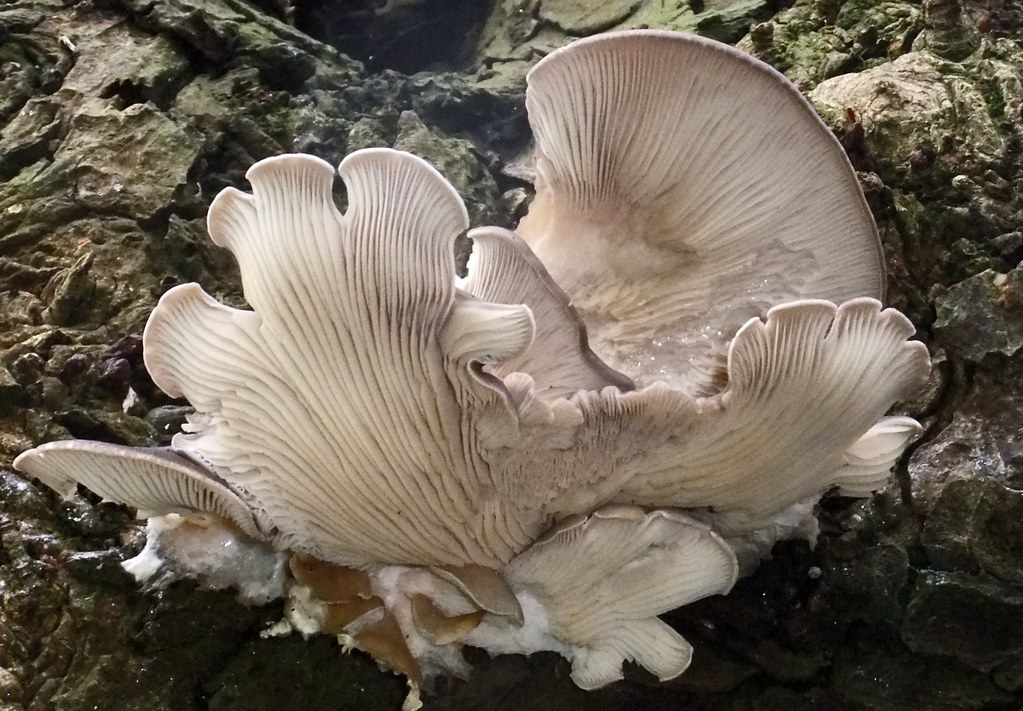
Oyster mushrooms (Pleurotus ostreatus) are a popular winter delicacy, thriving in cooler temperatures from October to April. Recognizable by their oyster-like shape and color variations ranging from blue-gray to cream, they feature a greasy cap measuring 5 to 20 cm in diameter. Their short, white stem often supports lamellae that extend far down its length, making them easily identifiable and a great choice for novice foragers.
These mushrooms typically flourish on dead or decaying tree trunks, often in clusters, inviting exploration of their winter habitat. With minimal pest issues, they can be harvested by simply detaching them from their substrate and brushing off any debris. The tough stem should be discarded before cooking, as the cap offers the most flavor.
Versatile in the kitchen, oyster mushrooms complement various dishes, from hearty mushroom lasagna to simple sautéed preparations with butter, garlic, and fresh herbs. Their high water content requires careful cooking to achieve the best texture. Whether enjoyed fresh or preserved by freezing or drying, oyster mushrooms embody the essence of winter foraging.
Herald of Winter
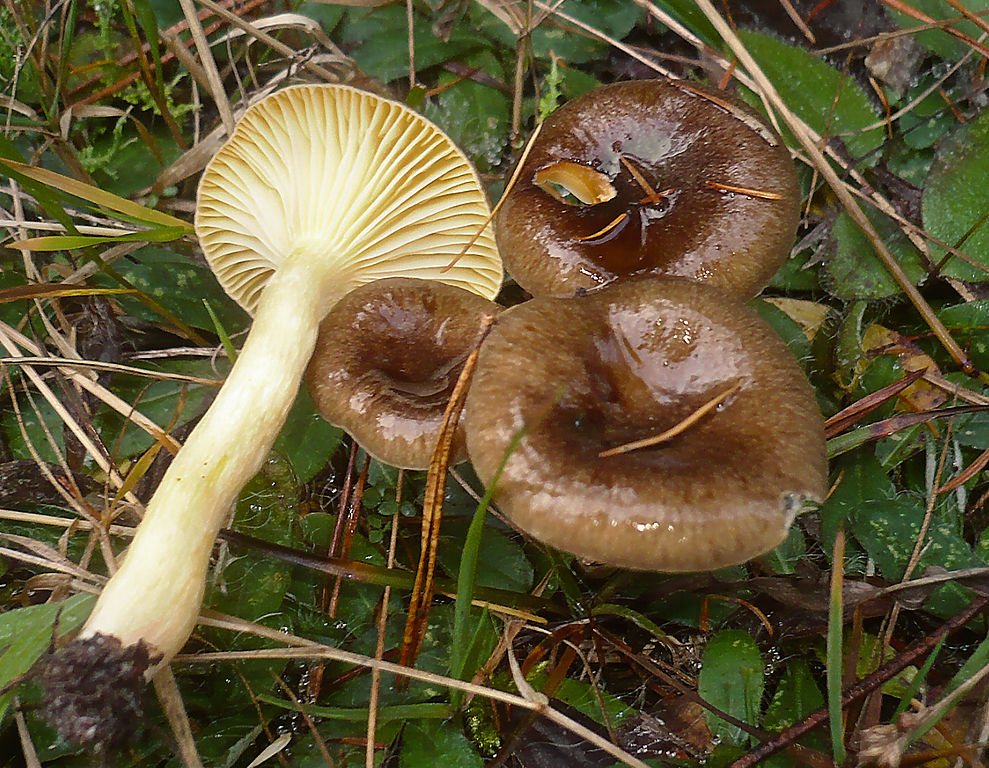
The herald of winter (Hygrophorus hypothejus) is an edible fungus that emerges in late autumn, often with the season’s first frosts. Known for its olive-brown waxy cap, this mushroom thrives in coniferous forests across Europe and is especially appreciated in northern Scandinavia.
For those eager to explore foraging, the herald of winter presents a wonderful opportunity to diversify your culinary experiences. Here are four key attributes to consider:
- Fruiting Period: Appears after the first frosts, typically throughout December.
- Habitat: Grows in loose swarms and small clusters under conifers, especially pine.
- Preparation: Requires cooking to release its watery juices until it becomes crispy around the edges.
- Identification: Recognized by its slimy cap (3-6 cm), pale yellow gills, and cylindrical stem.
As winter envelops the landscape, the herald of winter symbolizes the resilience of nature and the joy of foraging.
Benefits of eating mushrooms in winter
Incorporating mushrooms into your winter diet offers several health benefits that can enhance your well-being during the colder months. These versatile fungi are not only flavorful but also packed with essential nutrients.
Here are four key benefits of consuming mushrooms in winter:
- Immune System Support: Mushrooms are rich in antioxidants and beta-glucans, which can help strengthen your immune system and protect against seasonal illnesses.
- Vitamin D Source: With reduced sunlight in winter, mushrooms provide a valuable source of vitamin D, important for bone health and immune function.
- Nutrient Density: Loaded with vitamins and minerals, mushrooms offer vital nutrients such as B vitamins, selenium, and potassium, supporting overall health.
- Culinary Versatility: Their unique flavors and textures enhance winter recipes, adding depth to soups, stews, and casseroles, making meals both nutritious and enjoyable.
Incorporating mushrooms into your winter meals is a simple way to boost health and nutrition during the colder months.
FAQ
Do Morel Mushrooms Grow in Winter?
Morel mushrooms, known for their distinctive flavor and texture, do not grow in winter. These fungi thrive in conditions that winter does not offer. Morels prefer a balance of temperature and moisture, which is hard to find during the cold months.



